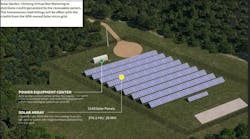In a wooded area outside Williamsburg, Va., Jay Epstein envisions efficient, healthy homes overlooking a creek, with views of deer and wild turkey running among the trees.
What makes Epstein’s vision distinctive is that these tree-nestled homes would also be solar powered. That would be possible for the 59 properties in his Solara Woods development because they would draw power not from rooftop panels but from a shared solar garden.
It’s no small irony that solar home projects typically cut down trees to make room for solar panels. Epstein thinks that doesn’t have to be the case for residential developments—and shouldn’t be.
“It doesn’t make sense that we should continue to clear our lands to get south and southeast exposure because we worry about the shadowing effect on homes,” says Epstein, owner of Healthy Communities, a zero-energy ready builder based in Williamsburg.
How and Why to Keep Trees in Solar Home Development
At Solara Woods, the solar farm will need just three acres of tree-free ground. After clearing for the roadway, the solar home project will keep 75 acres of trees out of 110 acres total.
By contrast, Epstein’s previous project, Walnut Farms, offered rooftop panels for its 75 zero energy ready homes—and he had to clear 30 of the development’s 35 acres.
Epstein is well aware of the environmental benefits of conserving trees, but he’s also looking at the boost to the bottom line.
At Walnut Farms, he spent $150,000 to remove the trees and then another $200,000 to landscape—including replanting trees. Plus, he estimates that, over the community’s lifespan, it will cost $90,000 to $100,000 for erosion and sediment maintenance, which trees would mitigate. In addition, the Walnut Farms homes had to be designed and positioned to maximize sun exposure.
RELATED: How a Virginia Builder Profits From Net-Zero Energy Homes
That’s all cost and work that would be saved in a shared solar home community like Solara Woods.
It’s about “simplicity in design and build,” Epstein says of shared solar, which is also called community solar or solar garden. “Let’s keep it simple.”
Hurdles for Shared Solar
The concept may be simple enough, but the legal and regulatory hurdles haven’t been. Epstein worked with Virginia State Senator Scott Surovell on a bill to allow for shared solar in the state. That bill passed last year.
However, the monthly service fee that the utility provider, Dominion Energy, will charge homeowners for shared solar remains an open question. For homeowners with rooftop solar, the provider charges its standard service fee of about $7 per month. But for shared solar communities, such as Solara Woods, it wants to charge over 10 times more: almost $75 per month. Which would make the project a lot less attractive to potential buyers.
Epstein contends the higher fee isn’t warranted. A solar garden, he says, involves less administrative and inspection work than rooftop panels, not more.
In November, Epstein will make his case to Virginia’s State Corporation Commission, which regulates utilities and has the final word on the service fee. “I’m sure we’ll win this issue,” Epstein says.
If he does, Solara Woods will have a solar garden. And if he doesn’t? “Worst-case scenario, these will be high-performance homes with the trees saved," but the homes won’t have solar.
RELATED: Tim O’Brien Goes Big With Net Zero
Epstein plans to begin developing the community’s infrastructure next spring and start selling the solar homes by early 2023. While homeowners at Walnut Farms each pay $14,500 for rooftop panels, Solara Woods owners each would pay $15,500 for the garden, but with the same guarantee of an average utility bill of $1.50 per day.
Rising Consumer Demand for Solar Homes
He feels confident that consumer desire for healthy, efficient, solar homes is there—and growing stronger. At Walnut Farms, he sold eight properties in all of 2020. In the first half of this year, he sold 25. “The concept has taken off,” he says.
He attributes the rising interest to people’s experience of cleaner air during the pandemic-era lockdowns. “The baby boomers remember blue skies, and the millennials now see it too. Those are the two strong forces leading my sales,” he says. “They’re concerned about the environment and want to make it better.”
